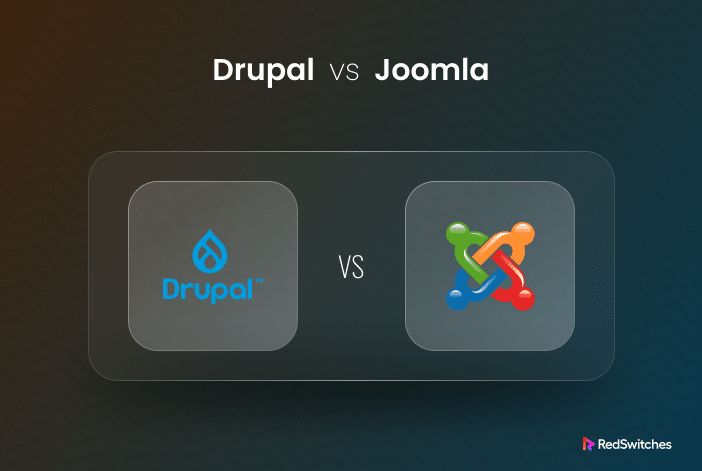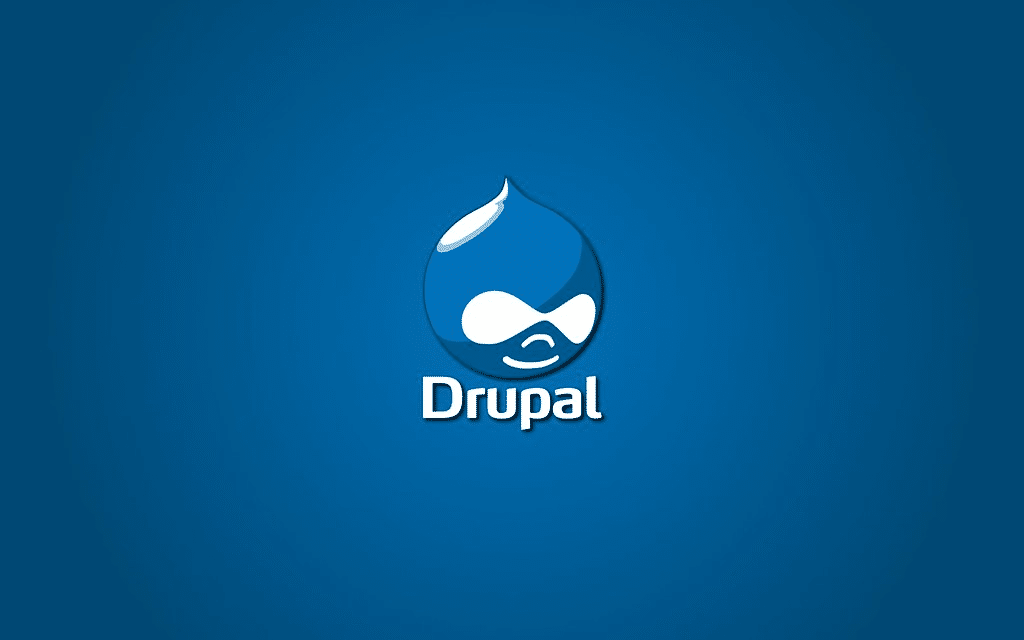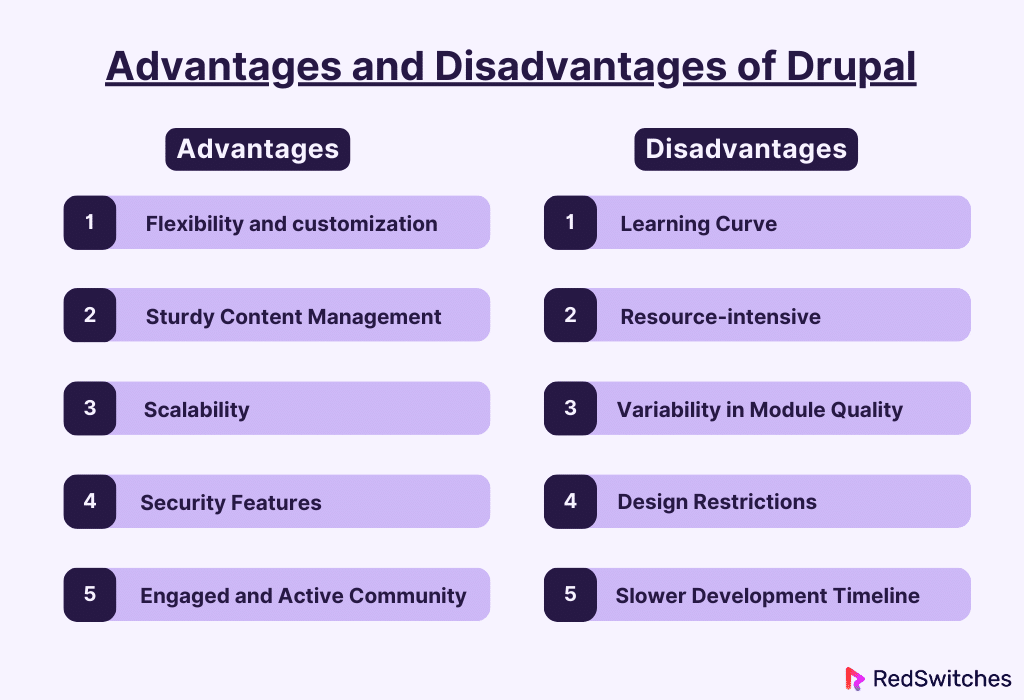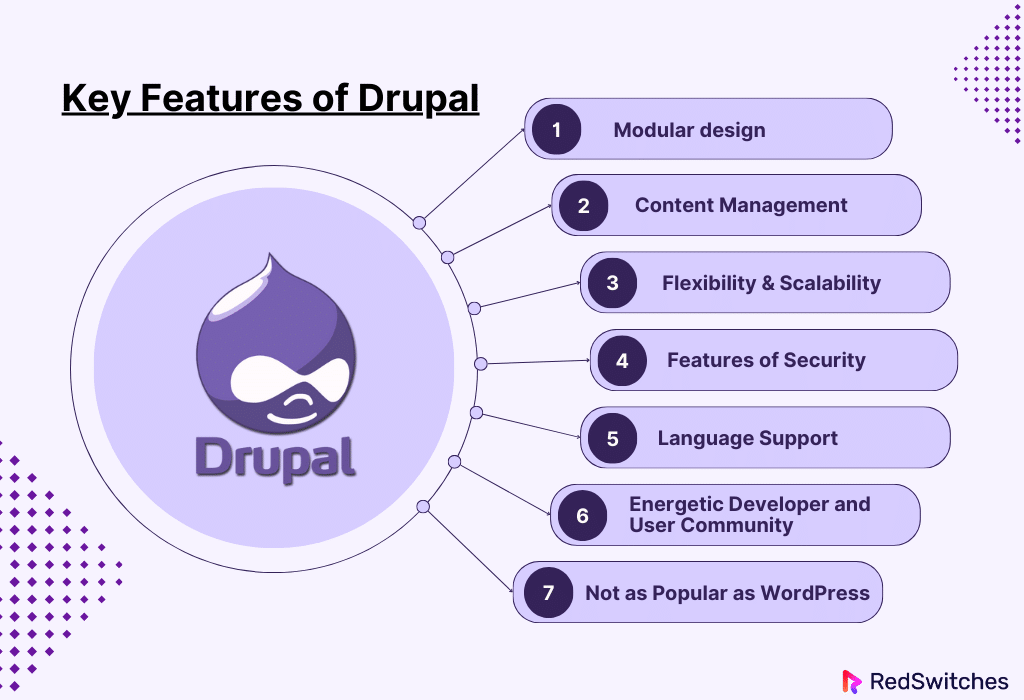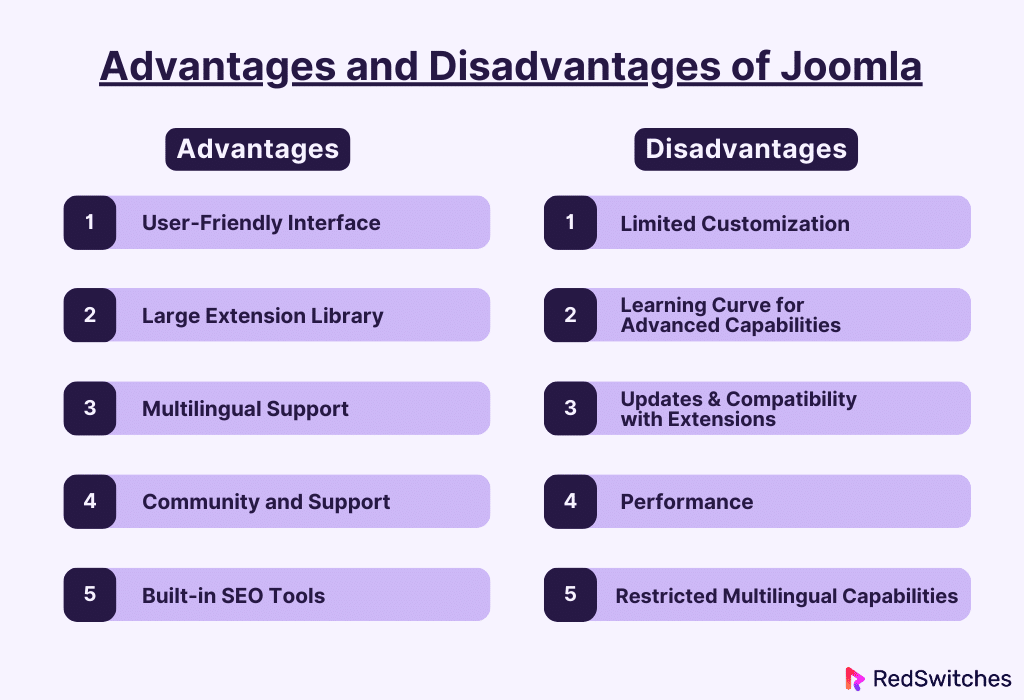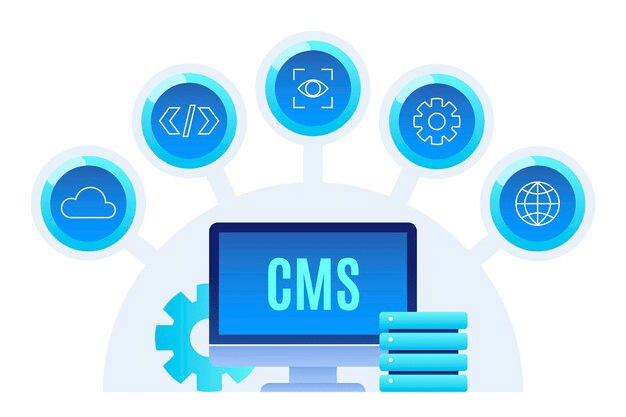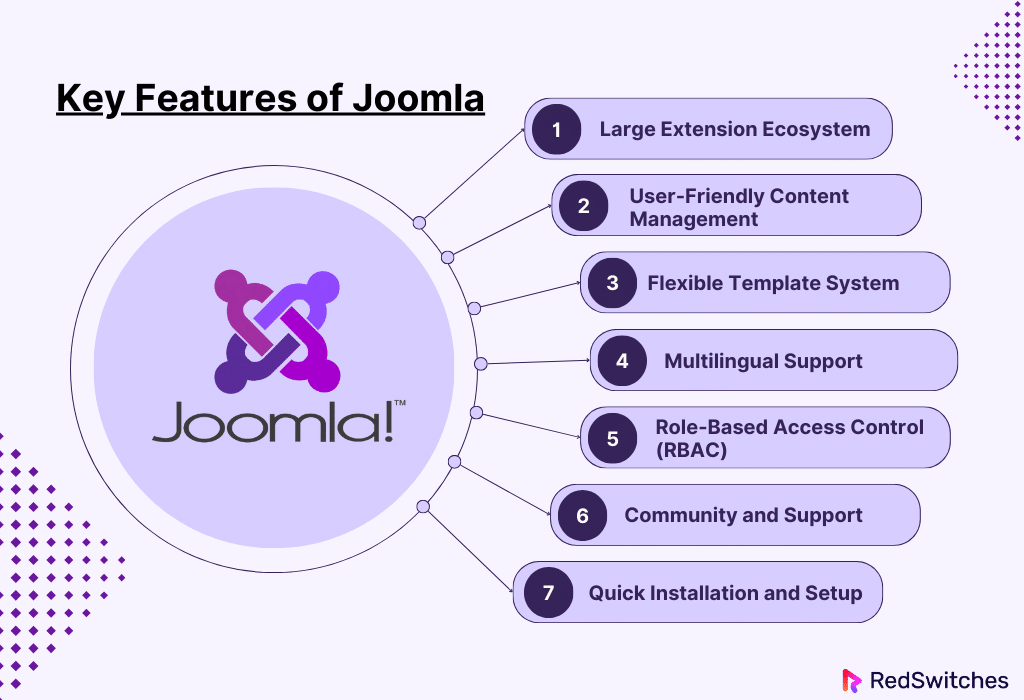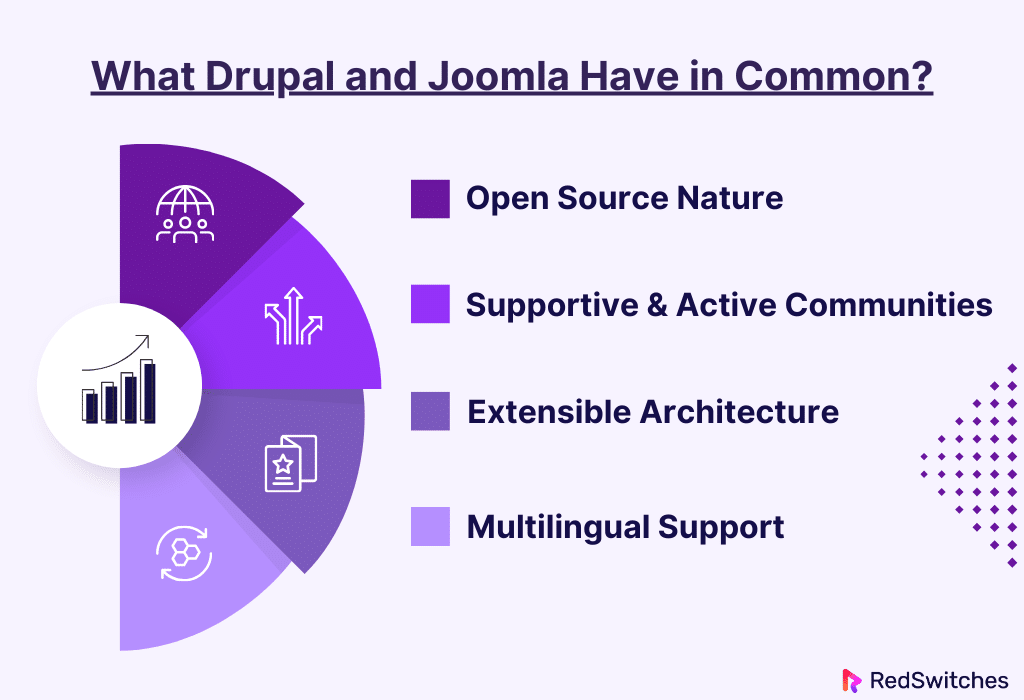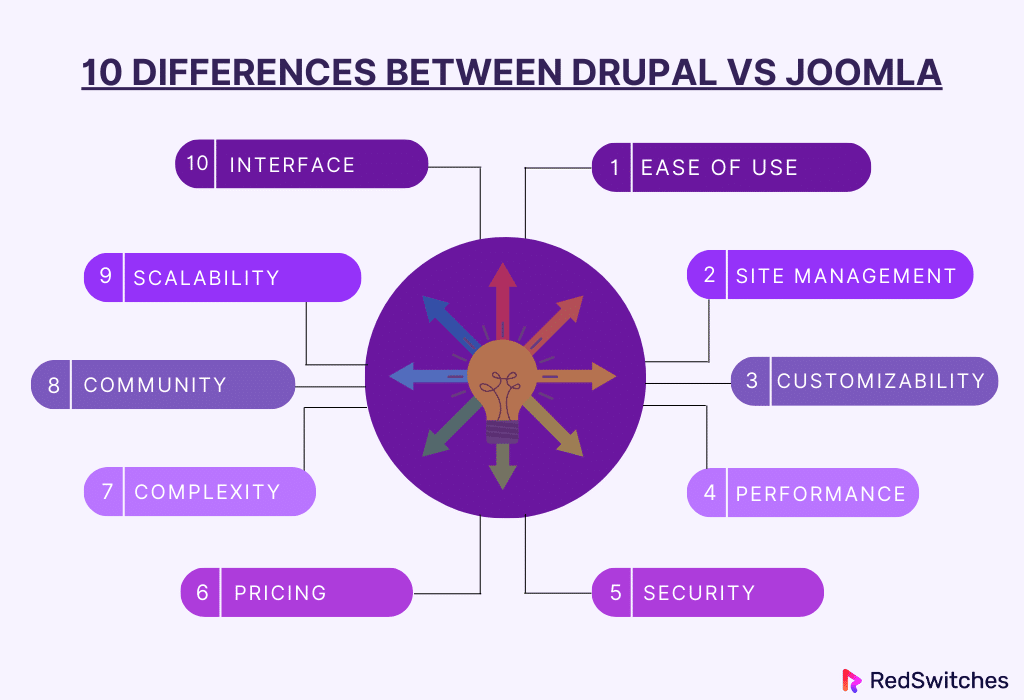Drupal and Joomla are two formidable titans in the vast and ever-changing world of content management systems, each with unique features and capabilities. For web developers and businesses alike, choosing between Drupal and Joomla is essential because navigating the digital world requires a stable platform. Imagine this battle as a virtual gladiatorial match where Joomla and Drupal square off with their specialties and advantages. We will understand the difference between Drupal and Joomla.
It’s not simply a comparison of codes and functionalities as we go into the crux of this conflict and unearth 10 noteworthy differences in the Drupal vs Joomla debate—it’s a story of innovation, user-friendliness, and the pursuit of the ideal digital kingdom. Let the struggle for domination commence!
Table of Contents
- What is Drupal?
- What is Joomla?
- What Drupal and Joomla Have in Common
- 10 Differences Between Drupal vs Joomla
- So, Which is better: Drupal or Joomla?
- Conclusion
- FAQs
What is Drupal?
Credits: flickr
Drupal is a customizable, free, open-source content management system that creates straightforward, intricate websites and online applications. With thousands of free modules and themes, Drupal expands to help you reach the online audience you require to spread your message, increase brand recognition, and forge your community.
Drupal is multilingual and easily accessible. The most potent and approachable version of Drupal is the most recent release. You may be sure you can reach the audience you’re looking for to express your message because Drupal has multilingual and accessible features.
Advantages and Disadvantages of Drupal
In this section of the blog article, we will discuss the advantages and Disadvantages of Drupal.
Advantages
Flexibility and customization
Drupal is well known for having a high degree of flexibility and customization. It enables programmers to design highly customized websites and applications that can be calibrated to meet various demands. Drupal’s modular architecture allows different modules to be integrated, making it a flexible platform for various applications.
Sturdy Content Management
Drupal’s design revolves around content management. Because of its proficiency with intricate content structures, it is the best option for websites requiring a lot of content. Its content classification and taxonomy system guarantees effective content organization, enabling users to quickly handle massive amounts of information.
Scalability
Drupal’s intrinsic scalability makes it appropriate for various project sizes. Drupal can grow with your needs, whether you’re starting with a small website and intend to expand or build a large-scale business application. One key benefit is its capacity to manage growing traffic and content without compromising efficiency.
Security Features
Strong security features are one of Drupal’s best-known attributes. The Drupal community quickly recognizes security flaws and takes appropriate action to fix them. Drupal offers a secure environment for websites and applications with frequent security upgrades and a specialized security team—a crucial feature for companies handling sensitive data.
Engaged and Active Community
There is a large and vibrant Drupal community. Users, developers, and designers actively participate in forums, exchange knowledge, and produce themes, modules, and extensions. For those who use Drupal, this community-driven model guarantees continual support, constant improvement, and abundant resources.
Also Read Database Defense Blueprint: Ensuring Data Security in a Connected World
Credits: Freepik
Disadvantages
Learning Curve
Drupal has a steeper learning curve as a price for its flexibility and capability. The vast capabilities and configuration possibilities of Drupal may be intimidating to novices or users used to less complex platforms. Support and training can help to lessen this difficulty, though.
Resource-intensive:
Although the scalability of Drupal is a benefit, it may also work against smaller projects. When compared to specific other content management systems, the system requires more resources due to its robustness and abundance of features. This can impact hosting requirements and costs, particularly for smaller websites.
Variability in Module Quality
Drupal’s large module library has two drawbacks. Although it provides many features, the quality of these modules varies. While some can be less dependable, others might be updated frequently and kept up to date. Careful investigation and choice are essential to prevent possible incompatibilities.
Design Restrictions for Non-Developers
Drupal provides great design flexibility, but users unfamiliar with coding or design may find it challenging to create visually pleasing layouts. Although themes are accessible, the skills of a developer or designer may be necessary to get a distinctive and elegant look.
Slower Development Timeline
Drupal website development may take longer than certain more user-friendly CMS choices. The necessity for meticulous planning, setup, and customization—all of which can cause the development timetable to elongate—is frequently blamed for the time commitment.
Key Features of Drupal
So, now, let’s understand the key features of Drupal.
Modular design
Drupal’s modular design is the foundation of its power. Because the system is composed of several fully interoperable modules, developers can add to and modify the functionality of their websites or applications. This modular strategy offers scalability, flexibility, and the capacity to customize Drupal to satisfy particular project needs.
Content Management
Drupal is a master at content management, providing an advanced framework for arranging and showcasing a wide range of content kinds.
Content may be categorized appropriately and classified thanks to the sophisticated taxonomy system provided by the content management system (CMS). Drupal is the best option for projects involving complicated content structures because of this and its customizable content types.
Flexibility & Scalability
Drupal’s inherent scalability makes it appropriate for projects of various sizes and levels of complexity. Drupal is flexible enough to meet the needs of any size project, be it a large-scale enterprise application, a small blog, or a corporate website. Its adaptability is a crucial feature that enables programmers to design customized solutions for various requirements.
Features of Security
Drupal is well known for emphasizing security. The Drupal security team continuously analyses and fixes vulnerabilities, and the system has built-in security safeguards. Security updates are published regularly to guarantee that websites and apps built on Drupal have the newest defenses against potential attacks. Websites handling sensitive data especially need to be committed to security.
Language Support
One notable feature of Drupal is its extensive language support. Multilingual content creation and management is simple for websites with an international target audience. Regardless of a user’s preferred language, the system offers facilities for content translation, language-specific configuration management, and seamless user experience.
Energetic Developer, Designer, and User Community
The Drupal community is a thriving and dynamic ecosystem. This community-driven approach ensures that the Drupal platform is continuously improved, supported, and problem-solved. The forums, documentation, and contributions made by the Drupal community to the vast collection of user-accessible modules and themes are well-known.
What is Joomla?
Credits: Joomla
Joomla is reportedly one of the greatest open-source content management systems (CMS) for creating effective websites and online apps. It operates from the administrator side, is free, and may be divided into front-end and back-end templates. It is based on a model-view-controller architecture that is not dependent on the content management system.
The Joomla platform is built on top of PHP and MySQL. Third-party extensions and templates are also supported by Joomla, allowing for additional customization to satisfy specific needs. Anyone who wishes to build the templates and extensions is welcome to use them.
Also, Read Creating MySQL Tables: A Guide to Structuring Your Data
Advantages and Disadvantages of Joomla
After discussing the definition of Joomla, let’s focus on the Advantages and Disadvantages of Joomla open-source CMS.
Advantages of Joomla
User-Friendly Interface
Both novice and expert users may easily use Joomla’s well-known user-friendly interface. Users may manage content, adjust settings, and change the website’s layout using the user-friendly administrative panel without requiring complex technical knowledge. This simplicity of use for those unfamiliar with content management systems helps shorten their learning curve.
Large Extension Library
The Joomla Extensions Directory makes available a huge selection of Joomla extensions, such as plugins, modules, and templates. Thanks to this vast environment, users may improve their websites by adding new features, capabilities, and design options. A large selection of extensions is available to meet a variety of purposes, including social network integration and e-commerce solutions.
Multilingual Support
Drupal and Joomla offer extensive multilingual support to meet worldwide clientele needs. This feature facilitates the creation of websites that may effectively reach foreign audiences by enabling users to produce and manage material in several languages.
Community and Support
Joomla has an engaged and encouraging community that is vital to the platform’s continuous advancement. The community helps people with problems or seeking advice by providing forums, documentation, and resources. The Joomla community’s collaborative spirit guarantees a trustworthy support system for individuals and businesses utilizing the platform.
Built-in SEO Tools
Joomla has built-in SEO tools that help with the search engine optimization of websites. This covers settings for meta tags, URL structures, and other SEO-friendly elements that are changeable. Enhancing a website’s exposure in search engine results is made easier with the help of these elements, which also help improve organic search performance.
Credits: Freepik
Disadvantages of Joomla
Limited Customization and Versatility
Although Joomla has a fair amount of versatility, it can not be as customizable as systems like Drupal. Developers may encounter limits when attempting to implement very precise or complex needs. Advanced customization frequently demands a better understanding of the platform’s design.
Learning Curve for Advanced Capabilities
Although Joomla’s core capabilities are intuitive, novices may find it difficult to grasp the platform’s more complex functionality. It may take some time for users to become proficient in more difficult platform features if they want to take advantage of Joomla’s full capabilities, which include developing extensions and customizing templates.
Updates & Compatibility with Extensions
Although a great asset, the extensive collection of extensions can occasionally cause problems. It’s possible for extensions and the Joomla core to become incompatible, particularly after upgrades. Users must ensure their selected extensions are regularly updated and maintained to prevent conflicts and security flaws.
Performance
Compared to less complex content management systems, Joomla’s performance may be a factor for some users. Even if recent versions have improved performance, users might need to optimize their hosting setups and Joomla installations for speed and responsiveness.
Restricted Multilingual Capabilities Compared to Drupal,
Joomla certainly supports multilingual websites, but its features might not be as extensive as those of Drupal. Drupal might be a better fit for users with intricate multilingual needs.
Not as Popular as WordPress
Although Joomla has a sizable user base, WordPress is more widely used. Comparing this to other well-known CMS platforms may lead to a smaller community and fewer third-party resources.
Also Read 16 Tips on How to Increase Your Server Speed & Performance
Key Features of Joomla
Before moving towards our core debate topic, i.e., Drupal vs Joomla, let us understand the key features of Joomla.
Large Extension Ecosystem
Joomla’s large extension ecosystem is one of its best qualities. Modules, plugins, and templates are just a few extensions available through the Joomla Extensions Directory (JED). With the help of these extensions, users may improve their websites by adding new features, visual components, and integrations. Joomla’s extensive extension library meets a wide range of needs, including those for sophisticated SEO tools, social network integration, and robust e-commerce solutions.
User-Friendly Content Management
Joomla’s content management system (CMS) is well known for being user-friendly. Novice and seasoned users may easily manage material on the platform because of its simple and intuitive design. A user-friendly editor and a hierarchical framework that facilitates effective content classification and tagging streamline the process of creating and organizing material.
Flexible Template System
One of Joomla’s main features is its template system, which enables users to develop visually striking and distinctive websites. Because of the platform’s adaptable template structure, users can alter the appearance and feel of their websites to represent their brands better or meet particular needs.
Multilingual Support
Joomla has strong multilingual support, an essential feature for websites catering to a wide range of international users. The platform’s integrated language management features allow administrators to generate, edit, and arrange information in many languages.
Role-Based Access Control (RBAC)
Administrators can design and manage user roles and permissions with Joomla effectively! Thanks to this robust functionality. This fine control allows different user groups to be assigned different duties and access levels.
Community and Support
One of Joomla’s key features that helps with the platform’s continuous development and user support is its vibrant and friendly community. Developers, designers, and users participating in forums, discussions, and group projects are all part of the Joomla community.
Quick Installation and Setup
Joomla’s rapid and easy installation method is another important characteristic worth mentioning. Joomla provides an easy-to-use installation wizard that walks users through all the necessary steps to set up their websites quickly and effectively. This feature helps customers get their websites up and running quickly, especially for those who value a simple and quick initial setup.
Also read What Is a Website? Explore Its 4 Components
What Drupal and Joomla Have in Common
Despite having different approaches and designs, Drupal and Joomla have several things in common that make them popular content management systems (CMS).
Open Source Nature
Being open-source systems, Drupal and Joomla allow users to read, alter, and distribute their source code freely. Because the platforms are open-source, various developers can collaborate to improve them, promote community contributions, and promote collaborative development.
Supportive and Active Communities
Communities that are supportive and active are beneficial to both Drupal and Joomla. Developers, designers, administrators, and users make up these communities, and they all participate in forums, talks, and the development of new modules and extensions.
Extensible Architecture
Through modules or extensions, users can increase and alter the functionality of their websites on both CMS platforms. Although Joomla depends on extensions, Drupal uses modules, but the idea is the same.
Multilingual Support
Drupal and Joomla offer extensive multilingual support to meet worldwide clientele’s needs. This feature facilitates the creation of websites that may effectively reach foreign audiences by enabling users to produce and manage material in several languages.
10 Differences Between Drupal vs Joomla
Now, we come to the core topic of our blog: the Drupal vs. Joomla debate. Here, we will examine 12 critical differences between the top open-source operating systems.
Drupal vs Joomla: Ease of Use
Let us understand our debate on Drupal vs Joomla concerning user-friendliness.
Drupal
Despite being a strong and adaptable content management system (CMS), Drupal’s complexity sometimes makes it seem less user-friendly. The platform’s versatility allows for managing various content types and complex site structures, which is one of its most vital points.
But novices may find its administrative interface daunting, requiring a steep learning curve. Even with so much customization, there could be difficulties, especially for non-technical users. Despite this, Drupal has excellent scalability and is a good fit for big, intricate websites that receive a lot of traffic.
Joomla
Joomla is often easier for novices than Drupal since it balances flexibility and usability.
Its user-friendly administrative interface makes content administration and navigation simpler. Additionally, Joomla provides a wide range of add-ons that improve functionality without requiring high technical expertise.
Joomla’s user-friendly design and moderate learning curve make it a good option for individuals looking for a mix of simplicity and flexibility, even though it might not be as expandable as Drupal.
Drupal vs Joomla: Site Management
So, which has the better site management out of the two? We will discuss the site management parameter in this section of our Drupal vs Joomla argument.
Drupal
Site administration is where Drupal shines, particularly for intricate and expansive projects. Websites with complex content structures and a wide range of requirements are drawn to it because of its sturdy features and modular architecture.
Content can be arranged and classified with a great deal of freedom thanks to Drupal’s content types and taxonomy system. Additionally, managers can precisely regulate user access and permissions because of its fine-grained permissions system.
Joomla
Robust site management features are provided by Joomla, which can handle a variety of websites, from modest to medium-sized ones. Because of its intuitive administrative interface, people with different technical expertise can easily handle content administration responsibilities. The ecosystem of Joomla extensions offers more site management features, enabling users to improve their websites without requiring significant programming work.
Drupal vs Joomla: Customizability
Let us understand our debate on Drupal vs Joomla concerning customizabilty.
Drupal
Drupal is a popular option for websites with complicated and specialized requirements because of its unmatched customizability. The platform’s vast library of modules offers a multitude of functionalities to pick from, and its modular architecture enables developers to create and change various content types. The ability to precisely customize a website’s appearance is provided by Drupal’s theming system, which allows for the creation of highly customized and distinctive designs.
Joomla
Joomla can be significantly customized, making it appropriate for various website types. Without requiring significant development work, users can expand and improve website functionality with the help of the platform’s extension ecosystem, which offers a variety of plugins, modules, and components. The Joomla template system offers versatility in terms of design and makes it easier to customize the website’s appearance.
Drupal vs Joomla: Performance
The following parameter in our Drupal vs Joomla debate is their performance.
Drupal
Drupal is renowned for reliable performance, particularly for big, intricate websites. Efficient page loading times result from its caching systems, optimization features, and modular architecture. Drupal is a good fit for high-traffic websites because of its capacity to manage large amounts of content, user interactions, and complicated data structures.
However, careful configuration and administration may be necessary to achieve optimal performance in Drupal. To guarantee optimum performance, developers and administrators must pay close attention to caching settings, database optimization, and server parameters.
Joomla
Joomla also performs well for websites with modest complexity and size. Its architecture is made to manage different kinds of content well, and its template system enables aesthetically pleasing designs without sacrificing functionality.
Content delivery network (CDN) integration and integrated caching are two examples of Joomla’s performance enhancements. Even while these capabilities help pages load quickly, Joomla’s overall speed is sometimes considered easier to attain than Drupal’s.
Drupal vs Joomla: Security
Security is another crucial step in the Drupal vs Joomla argument.
Drupal
Security is a top priority for Drupal, and the community takes the initiative to fix vulnerabilities. The platform’s security team is quick to release updates and patches to fix any security flaws that are found. Security is a top priority in the architecture of Drupal’s core, and the platform’s large developer community is constantly working to improve its security features.
Contributed modules are subject to stringent examination, and security assessments are carried out before modules are approved for integration into the Drupal ecosystem.
Joomla
Joomla also prioritizes security, with a specialized security team actively addressing vulnerabilities. Like Drupal, Joomla swiftly addresses security vulnerabilities by releasing updates and patches. Security is a top priority in the architecture of the platform core, and efforts are taken to guarantee that donated extensions follow secure coding practices.
Joomla contributes to a more secure environment with features like SSL connection enforcement and two-factor authentication. Administrators can efficiently manage rights thanks to the platform’s administrative interface, which includes user access restrictions.
Drupal vs Joomla: Pricing
Pricing is probably one of the most crucial factors for any organization in the Drupal vs Joomla argument.
Drupal
Drupal can be used without cost because it is an open-source content management system. Drupal is free to download, install, and change for users. No license fees are required. Drupal’s open-source design also encourages a sizable and vibrant developer community that works to further the platform.
It’s crucial to remember that even though Drupal is free software, creating and maintaining a Drupal website could have additional charges. If professional help is needed, these expenses may also cover web hosting, domain registration, and development services.
Joomla
Joomla is an open-source content management system (CMS), much like Drupal, with its core software accessible for free download, usage, and modification. Users must not pay for licensing to utilize Joomla’s vast feature set.
But just like with Drupal, there can be expenses involved with creating and managing a Joomla website. Users may need to set aside money for domain registration, web hosting, and any expert services needed for development or customization.
Drupal vs Joomla: Complexity
Do not get us wrong; organizations prefer open-source systems that are simpler to use. Let us understand the complexity parameter in the Drupal vs Joomla debate.
Drupal
High levels of complexity are characteristic of Drupal, which can be both an advantage and a disadvantage. It is an effective tool for creating elaborate websites with complex content structures and specialized capabilities because of its flexibility and extensibility. However, because of its complexity, there may be a higher learning curve—especially for individuals with less technical know-how or experience with content management systems.
Joomla
Joomla is a less complicated platform than Drupal since it compromises flexibility and user-friendliness. Because of its more user-friendly administrative interface, users with different degrees of technical experience can use it. Beginners will find Joomla’s vocabulary and settings more user-friendly, which will help with the learning curve.
Although Joomla offers reasonable customization, it is not as flexible as Drupal.
Drupal vs Joomla: Community
Which has a more vibrant community? In this section of our Drupal vs Joomla debate, we will briefly explain the Community factor.
Drupal
Drupal has a strong and vibrant open-source community contributing significantly to the platform’s growth, enhancement, and upkeep. The Drupal community comprises global users, developers, designers, and site builders. The abundance of contributed modules, themes, and documentation that improve the platform’s functionality is the outcome of this community-driven approach.
The Drupal community is renowned for its collaborative nature, with members actively participating in debates, exchanging expertise, and working together to enhance the Drupal ecosystem.
Joomla
The open-source community for Joomla is likewise thriving, albeit possibly not as large as Drupal’s. The Joomla community comprises users, developers, designers, and site managers who support and build the platform.
The Joomla community actively collaborates via mailing lists, forums, and events like JoomlaDay. The community-driven concept guarantees the availability of numerous extensions, templates, and tools to improve Joomla’s websites.
Drupal vs Joomla: Scalability
Scalability and reliability are crucial in the Drupal vs Joomla long-lasting debate.
Drupal
Because of its well-known scalability, Drupal is frequently chosen for large, intricate websites with a lot of content and heavy traffic. The modular architecture of the platform makes it possible to create digital experiences that are both adaptable and scalable. Drupal is a good choice for enterprise-level scalability because of its versatility in handling complex content structures, a wide range of content kinds, and strong user permissions.
Joomla
Joomla can also scale well, especially for medium-sized and larger websites. Its architecture makes creating websites with a wide range of features and content possible. Thanks to its modular design and extension ecosystem, Joomla offers more features and scalability choices.
Joomla might not be as scalable as Drupal for vast and sophisticated projects. However, it is still a good option for companies and organizations that need to scale up or down significantly.
Drupal vs Joomla: Interface
User interface is a crucial factor to consider in the Drupal vs Joomla debate.
Drupal
Despite its strength, Drupal’s administrative interface is sometimes regarded as being more complicated than that of certain other content management systems, and it could also have a higher learning curve. For newcomers, the vocabulary and setting organization in Drupal can be intimidating. However, the great degree of customization and flexibility that Drupal provides comes at a cost: complexity.
Because of Drupal’s modular interface, users can quickly and easily retrieve pertinent information and customize their dashboards.
Joomla
The administrative interface of Joomla is more approachable, especially for novices, because to its user-friendly design. The menu layout and vocabulary are designed to accommodate users with different degrees of technical proficiency. The Joomla interface is often easier to use, which makes the learning curve less steep.
Quick access to key features is possible through Joomla’s dashboard, and the platform prioritizes usability without compromising capability.
Let’s summarize the differences in a tabular format for a clear overview.
So, Which is better: Drupal or Joomla?
Credits: Freepik
The final decision in the Drupal vs Joomla debate is based on the user’s or organization’s particular requirements, tastes, and level of technical proficiency. Drupal is a powerful and highly configurable platform that developers and companies with complex needs prefer. It is appropriate for complicated, large-scale projects because of its feature-rich feature set and modular architecture. Meanwhile, the intricacy and higher learning curve could be intimidating for newcomers.
However, Joomla is a great option for people who value simplicity due to its intuitive design and more direct approach. It is appropriate for people with different technical backgrounds and tiny to medium-sized websites. Joomla is accessible and functional in equal measure. However, it might not be suitable for users who need extensive customization.
For users looking for unmatched flexibility and control, Drupal is essentially perfect, especially for large-scale, enterprise-level projects. Because of its ease of use and simplicity, Joomla is a better choice for individuals, small organizations, and projects with less complicated requirements. In the end, the “better” option will rely on the particular objectives and features of the undertaking.
Credits: Freepik
Conclusion
Within the ever-evolving field of content management systems, choosing between Drupal and Joomla is a crucial decision that involves many factors and subtleties. During this investigation, we examined each system’s definitions, benefits, and drawbacks, identifying their salient attributes and differentiators.
The ten salient distinctions between Drupal and Joomla exposed the advantages and disadvantages, encompassing user-friendliness, expandability, safety, and user interface. Each platform serves a different range of users with its features, from experienced developers looking for Drupal’s unmatched customization to novices finding comfort in Joomla’s welcoming environment.
RedSwitches is a reliable and performant Dedicated Servers hosting solution for anyone looking for something more to go along with their Drupal or Joomla projects. Our hosting solutions provide the groundwork for a smooth online presence by being specifically designed to satisfy the needs of dynamic websites and applications.
When you set out on your digital journey, consider how your selected content management system and our hosting expertise can work together to create a simple website and an online experience tailored to your goals.
FAQs
Q. Drupal vs Joomla: What is the critical difference?
The key distinction is in the degree of customization and complexity; while Joomla prioritizes user-friendliness, Drupal offers a greater degree of freedom.
Q. What is better, Joomla or WordPress?
The choice depends on specific needs; Joomla suits those who value simplicity, while WordPress is favored for its extensive ecosystem and user-friendly interface.
Q. Is Joomla good for SEO?
Yes, Joomla is SEO-friendly, with built-in features like customizable URL structures and meta tags, supporting effective search engine optimization.
Q. What is Joomla famous for?
Joomla is renowned for its user-friendly interface, making it approachable to a broad range of users, and its extensive extension ecosystem.
Q. Why use Joomla over WordPress?
Joomla may be preferred for its balanced approach to customization and simplicity. It caters to users who seek powerful features without an overwhelming learning curve.
Q. What is the difference between wordpress Joomla and Drupal?
WordPress is best for blogs and small to medium-sized sites with a user-friendly interface and a vast plugin ecosystem; Joomla suits community sites with advanced features and a balance of flexibility; Drupal is ideal for large, complex websites, providing high performance and scalability.
Q. What is the difference between Joomla and Drupal?
Joomla and Drupal are both popular content management systems (CMS) used for creating and managing websites. While Joomla is known for its user-friendliness and ease of use, Drupal is preferred for its flexibility and scalability, making it suitable for building complex websites and web applications.
Q. Which CMS is more suitable for a beginner – Joomla or Drupal?
Joomla is generally considered more beginner-friendly due to its intuitive interface and easier learning curve. On the other hand, Drupal might be more challenging for beginners due to its complex architecture and extensive customization options.
Q. What are the specific advantages of using Joomla?
Joomla is favored for its extensive library of templates and extensions, making it easier to customize the appearance and functionality of a website. Additionally, Joomla has a strong community support and is suitable for building medium-sized websites, such as corporate sites, e-commerce platforms, and social networking sites.
Q. What makes Drupal stand out as a CMS?
Drupal is known for its robust and flexible architecture, making it a preferred choice for building highly customized and enterprise-level websites. It offers advanced features for content organization, workflow management, and user permissions, making it suitable for complex web projects and web applications.
Q. How does WordPress compare to Joomla and Drupal in 2024?
WordPress, Joomla, and Drupal are all popular CMS options, each with its own strengths. WordPress is widely known for its user-friendly interface and vast plugin ecosystem, making it suitable for beginners and small to medium-sized websites. On the other hand, Joomla and Drupal excel in offering more advanced customization options and scalability for larger and complex web projects.
Q. Which CMS offers better security features – Joomla or Drupal?
Both Joomla and Drupal are known for their strong focus on security. However, Drupal is often perceived as having a more robust security architecture, particularly due to its more strict coding standards and dedicated security team. Nevertheless, proper security measures and regular updates are essential for maintaining the security of any CMS.
Q. Can I migrate my website from Joomla to Drupal or vice versa?
Yes, it is possible to migrate a website from Joomla to Drupal or vice versa. However, the process may involve complexities, especially if the website has a large amount of custom content and functionality. It’s advisable to seek professional assistance or use migration tools to ensure a smooth transition.
Q. Which CMS is more suitable for e-commerce websites – Joomla or Drupal?
Both Joomla and Drupal offer extensions and modules for creating e-commerce websites. Joomla has popular e-commerce extensions like VirtueMart and HikaShop, which are user-friendly and suitable for small to medium-sized online stores. Drupal, on the other hand, provides e-commerce solutions such as Drupal Commerce, known for its flexibility and scalability, making it more suitable for larger and complex e-commerce projects.
Q. Are there any notable differences in community support and developer resources for Joomla and Drupal?
Both Joomla and Drupal have active and supportive communities, offering a plethora of resources, forums, and documentation. However, Drupal is often associated with a more technically adept and developer-focused community, resulting in a wealth of advanced development resources and discussions. Joomla, on the other hand, is known for its user-friendly community and extensive documentation suitable for beginners and non-technical users.
Q. How can I determine the right CMS for my specific web development needs?
When choosing between Joomla and Drupal, it’s essential to consider the specific requirements of your web project. If you prioritize user-friendliness, sleek design options, and a strong community support, Joomla might be the right choice. On the other hand, if you need extensive customization, scalability, and robust security features for a large-scale or enterprise-level web project, Drupal might be the more suitable option.
